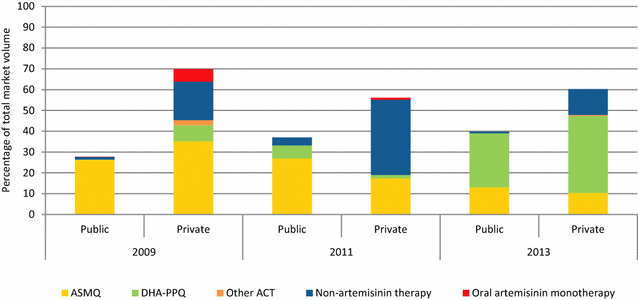Evidence of successful malaria case management policy implementation in Cambodia: results from national ACTwatch outlet surveys
- PMID: 27059952
- PMCID: PMC4826540
- DOI: 10.1186/s12936-016-1200-2
Evidence of successful malaria case management policy implementation in Cambodia: results from national ACTwatch outlet surveys
Abstract
Background: For over a decade, Cambodia has implemented a number of policies and innovative strategies to increase access to quality malaria case management services and address the drivers of multi-drug resistance. This paper utilizes outlet survey trend data collected by the ACTwatch project to demonstrate how changes in Cambodian policy and strategies have led to shifts in anti-malarial markets.
Methods: Anti-malarial ACTwatch outlet surveys were conducted in Cambodia in 2009 (June-July), 2011 (June-August) and 2013 (September-October). A census of all outlets with the potential to sell or distribute anti-malarials was conducted within a nationally representative sample of communes. Drug information, sales/distribution in the previous week, and retail price were collected for each anti-malarial in stock. Information on availability of malaria blood testing was also collected.
Results: A total of 7833 outlets were enumerated in 2009, 18,584 in 2011, and 16,153 in 2013. The percentage of public health facilities with at least one anti-malarial in stock on the day of the survey increased between 2009 (65.8%) and 2011 (90.0%) and remained high in 2013 (82.0%). Similar trends were found for village malaria workers (VMW). Overall, private sector availability of anti-malarials declined over time and varied by outlet type. By 2013 most anti-malarial stocking public health facilities (81.5%), VMW (95.4%), private for-profit health facilities (64.8%), and pharmacies (71.9%) had the countries first-line artemisinin-based combination therapy (ACT) treatment in stock. In 2013, 60% of anti-malarials were delivered through the private sector, 40% through the public sector, and the most common anti-malarial to be sold or distributed was the first-line ACT, comprising 62.8% of the national market share. Oral artemisinin monotherapy, which had accounted for 6% of total anti-malarial market share in 2009, was no longer reportedly sold/distributed in 2013. Malaria blood testing availability remained high over time among public facilities and VMW, with availability over 90% in 2011 and 2013. Moderate availability was observed in the private sector.
Conclusions: Continued implementation of successful public and private sector strategies in support of evolving malaria drug treatment policies will be important to protect the efficacy of anti-malarial medicines and ultimately facilitate malaria elimination in Cambodia by 2025.
Keywords: Anti-malarial; Availability; Elimination; Market share; Outlet; Private sector; Public; Supply; Treatment.
Figures








References
-
- WHO. World Malaria Report 2014. Geneva: World Health Organization. 2014.
-
- CNM. Strategic plan for elimination of malaria in Cambodia 2011–2025 DRAFT. Phnom Penh: Ministry of Health. 2015.
Publication types
MeSH terms
Substances
LinkOut - more resources
Full Text Sources
Other Literature Sources
Medical
Miscellaneous

